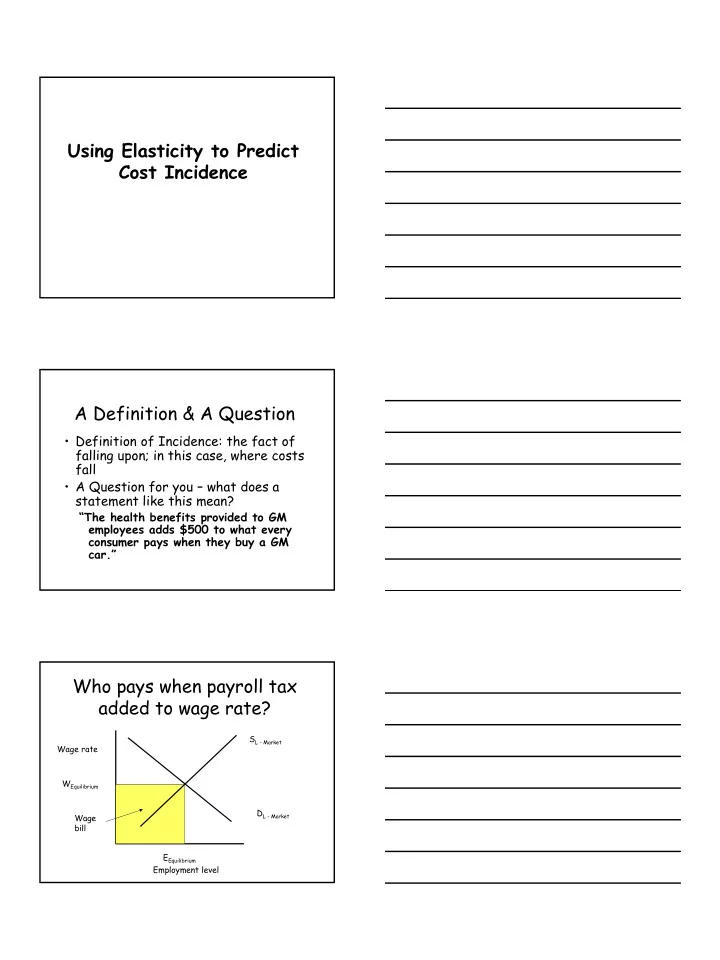

Using Elasticity to Predict Cost Incidence A Definition & A Question • Definition of Incidence: the fact of falling upon; in this case, where costs fall • A Question for you – what does a statement like this mean? “The health benefits provided to GM employees adds $500 to what every consumer pays when they buy a GM car.” Who pays when payroll tax added to wage rate? S L - Market Wage rate W Equilibrium D L - Market Wage bill E Equilibrium Employment level 1
Remember Own-Price Elasticities • Demand: • Supply: – Higher the elasticity, – Higher the greater demand elasticity, greater response to price supply response to change price change S E S I W with tax W 0 D E D I Change in Emp. Change in Emp Change in Emp Change in Emp When D E when S E When D I when S I Who Bears Cost of New Payroll Tax? • Case 1: – Employer D 0 bears W 0+ tax entire cost – Possible in S 0 very short W 0 run in firm where demand is perfectly inelastic E 0 Employer loss Who Bears Cost of New Payroll Tax? • Case 2: – Employees S 0 bear entire cost in form of lower wages W 0 – Possible in short run in D 0 firm where W 0- tax supply is perfectly inelastic E 0 Employee loss 2
Who Bears Cost of New Payroll Tax? • Case 3: Shared Cost (Moderate elasticity of supply S 0 & demand) W 0 +tax – Employees bear W 0 cost in form of lower wages & W * employment W 0 - tax D 0 – Employer bears cost in form of wage reduction E 0 E * E t less than tax Employer loss Employee loss Point: • The more inelastic the demand for labor, the less employment will decrease with a payroll tax, i.e., the firm will bear more of the cost of a payroll tax, ceteris paribus • The more inelastic the supply of labor, the smaller the decrease in supply, i.e., labor will bear the cost of a payroll tax, ceteris paribus COMPENSATING WAGE DIFFERENTIAL WAGES & OCCUPATIONAL CHOICE 3
ASSUMPTIONS ABOUT WORKERS • Utility maximization • Perfect worker information • Perfect worker mobility ⌦ Jobs have different non-pecuniary characteristics ⌦ Individuals differ in preferences for non-pecuniary characteristics Definition Compensating wage differential – Premium firms have to offer workers to compensate for working conditions – Can have both “positive” and “negative” premium MARKET FOR NON-MONEY CHARACTERISTICS OF WORK � IMPLICIT PRICE of non-pecuniary job characteristics – Positive differential for negative characteristics – Negative differential for positive characteristics � One explanation why more than 1 wage rate in labor market 4
EMPLOYEE PERSPECTIVE • TRADE-OFF BETWEEN EARNINGS & NEGATIVE JOB ATTRIBUTE – Constant Utility – Slope = Rate of exchange between wage & negative job aspect – Diminishing marginal returns – Preferences differ across individuals Employee Trade-off Wages (good) Risk (bad) People differ More Risk Averse Wages Less Risk Averse (good) Risk (bad) 5
EMPLOYER CONSIDERATIONS • TRADE-OFF BETWEEN – Cost of reducing negative aspects of job – Cost of compensating employees to put up with those aspects • Firm offer is bounded – Upper bound : Competitive mkt. ->0 profits – Lower bound: Need sufficient # workers • Firms vary in ability to change aspects Firm Trade-off Below 0 profits Zero Profits Above 0 profits Wages Risk Firms differ Expensive Inexpensive Wages Risk 6
THE OFFER CURVE • DEFINITION: Curve of all employers in market – Wage/Job characteristics combinations from which workers can choose – Market clearing implicit price • Offer curve can shift over time – Technological Change – Change in worker preferences The Offer Curve Wages Risk MATCH BETWEEN EMPLOYEES AND EMPLOYERS (Another Constrained Maximization Problem) • WORKERS: Maximize utility s.t. offer constraint (highest wage for given risk or lowest risk for given wage) • EMPLOYERS: Set wage high enough to attract enough but not too many • THE MATCH: Utility maximized at tangency b/n utility & offer curves 7
Matching workers to employers Individual Workers’ Market Utility offer curve Wages Risk INSIGHTS FROM COMPENSATING WAGE DIFFERENTIAL MODEL • Wages increase with risk (or any uniformly bad aspect), ceteris paribus • Workers with strong preferences (aversion) for job aspect will work at firm that provides that most cheaply (reduces it at lowest cost) • CWD allocates labor • Source of equity in compensation 8
Recommend
More recommend